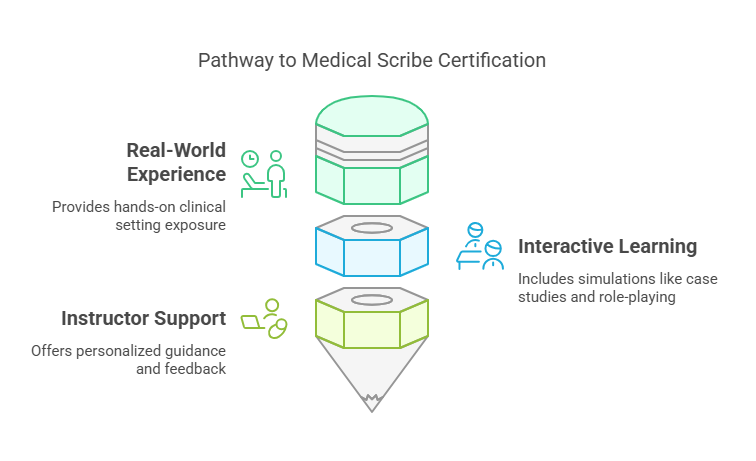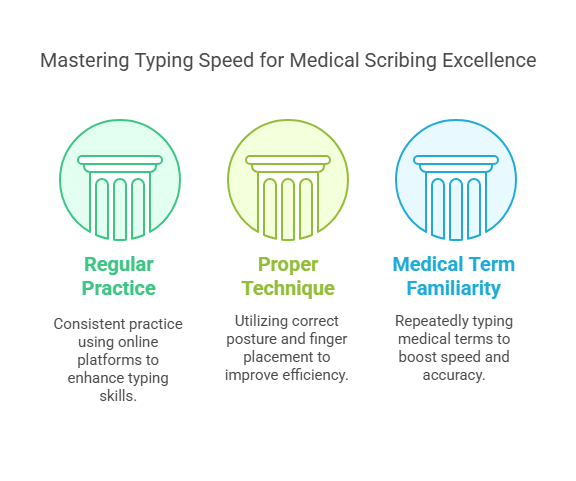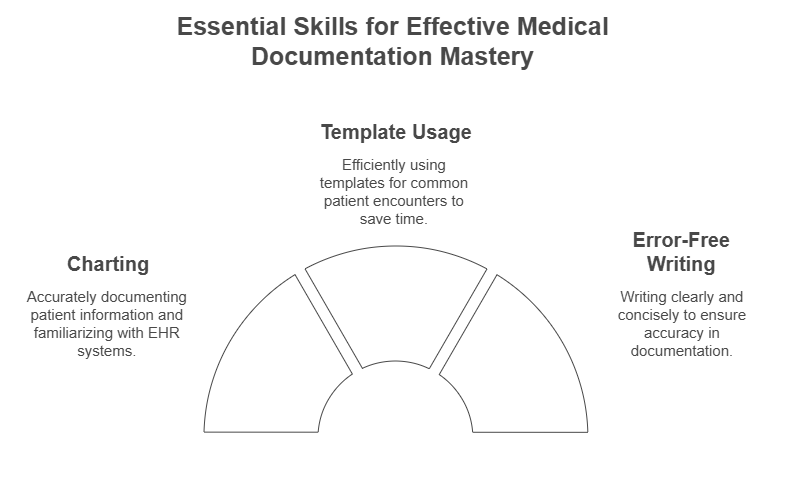How to Pass the Medical Scribe Certification Exam on the First Try
Becoming a certified medical scribe is a rewarding career step for anyone interested in the healthcare industry. A medical scribe plays a vital role in supporting healthcare providers by documenting patient information in real-time during medical visits. If you are preparing for your medical scribe certification exam, passing it on your first try is crucial to kickstart your career without delays. This guide will give you the best strategies, tips, and resources to help you succeed.
Understand the Exam Structure
The medical scribe certification exam is designed to test a wide range of knowledge essential for working as a medical scribe. Typically, the exam is composed of multiple-choice questions, each focusing on different aspects of healthcare. These questions will assess your understanding of various topics such as medical terminology, anatomy, physiology, healthcare procedures, and documentation practices. Additionally, situational questions may be included, which will require you to apply your knowledge to real-world medical scenarios. This ensures that you can not only recall information but also use it effectively in a clinical setting.
Key Areas to Focus On:
Medical Terminology: It's vital to familiarize yourself with common medical terms. This includes words related to body systems, diseases, diagnostic terms, medications, and treatment procedures. Having a solid grasp of medical terminology will help you document patient information accurately.
Anatomy and Physiology: Understanding the major body systems—such as the cardiovascular, respiratory, and nervous systems—and how they interact is essential. You should be able to identify different organs, their functions, and the relationships between various physiological processes.
Healthcare Procedures: Gain knowledge of common medical procedures, diagnostic tests, and treatments that are frequently documented in a healthcare environment. Knowing how to document these accurately will be key to your success during the exam and in your role as a medical scribe.
Review the Official Study Guide
One of the most effective ways to prepare for the medical scribe certification exam is by reviewing the official study guide provided by recognized certification bodies, such as the American Healthcare Documentation Professionals Group (AHDPG). This guide is tailored to provide you with a comprehensive understanding of all the topics that will be covered on the exam.
The study guide includes:
Practice Questions: These help you familiarize yourself with the exam format and test your knowledge of key topics. Regular practice will build your confidence and improve your performance.
Topic Breakdowns: The guide offers detailed explanations of each subject area, ensuring you understand the material thoroughly.
Exam Tips: The guide also provides insider strategies to help you manage your time effectively during the test, ensuring you can complete all sections within the allotted time.
Take Medical Scribe Courses
Enrolling in an accredited medical scribe training program is one of the best ways to prepare for the certification exam. These programs provide you with both the theoretical knowledge and practical skills necessary for efficient medical documentation. By participating in a comprehensive training course, you will gain in-depth exposure to the everyday responsibilities of a medical scribe, including real-time documentation, understanding medical terminology, and learning the flow of clinical processes. Many accredited programs are designed specifically to prepare candidates for the certification exam, ensuring you're fully equipped to pass on your first attempt.
Benefits of Medical Scribe Courses:
Real-World Experience: These courses often offer hands-on experience in a clinical setting, allowing you to observe and practice medical documentation under the supervision of professionals. This exposure helps you understand the day-to-day operations of a healthcare facility.
Interactive Learning: Many programs include interactive learning opportunities, such as case studies, group discussions, and role-playing activities. These simulations mimic real-life scenarios and help reinforce your skills.
Instructor Support: With personalized guidance from experienced instructors, you can ask questions and get feedback on your progress, helping you strengthen areas where you may need improvement. The one-on-one support increases your chances of success in both the course and the certification exam.
Practice with Sample Tests
A great way to prepare for the certification exam is by practicing with sample tests or mock exams. These practice exams help you become comfortable with the types of questions you'll encounter and allow you to assess your strengths and weaknesses.
You can find practice exams online or in study guides, and some medical scribe certification organizations even offer official practice exams. By taking these tests regularly, you can identify which areas you need to focus on and track your progress as you study.
Improve Your Typing Speed
As a medical scribe, the ability to type quickly and accurately is crucial. You will be expected to document patient information in real-time during medical visits, which demands speed without sacrificing precision. The faster and more accurately you can type, the better you will perform on the certification exam and in everyday work. Improving your typing speed will help you keep up with the pace of medical professionals while ensuring all vital information is captured correctly.
Tips for Improving Typing Speed:
Practice Typing Regularly: Consistent practice is essential for boosting your typing speed and accuracy. Utilize online typing platforms, such as TypingClub or Keybr, to practice regularly. These websites offer exercises and games designed to enhance both speed and precision, allowing you to track your progress over time.
Use Proper Technique: Learning proper typing posture and finger placement is key to improving your efficiency. Maintain a neutral wrist position, use all your fingers, and practice good posture to avoid strain and errors. Proper technique minimizes fatigue and reduces the chance of mistakes, which is crucial when documenting complex medical terms.
Practice with Medical Terms: Medical scribing involves typing a large number of specialized terms related to anatomy, diseases, treatments, and medications. To improve both speed and accuracy, practice typing medical terms frequently. Familiarizing yourself with these terms will help you type them without hesitation, increasing both your speed and accuracy during the exam and in clinical settings.
Study Anatomy and Medical Abbreviations
A solid understanding of human anatomy and medical abbreviations is critical for passing the medical scribe certification exam. Medical scribes are often required to document patient information quickly, which makes the use of medical abbreviations essential. Knowing the correct abbreviations not only saves time but also ensures accuracy in documentation.
Resources for Learning Anatomy and Abbreviations:
Medical Flashcards: Flashcards are a great tool for memorizing important anatomical terms, medical procedures, and abbreviations. You can create your own or use pre-made flashcards available online to reinforce your knowledge.
Anatomy Apps: Apps like Visible Body or Complete Anatomy offer interactive 3D models that help you learn the body’s systems, organs, and functions. These apps make studying anatomy more engaging and can enhance your understanding of how the body works.
Medical Abbreviation Lists: Many online resources provide comprehensive lists of common medical abbreviations. Reviewing and practicing these abbreviations regularly will help you become more familiar with them and use them accurately when documenting patient information.
Master Documentation Practices
Effective documentation is central to the role of a medical scribe, and mastering this skill is essential for both the certification exam and your long-term success in the field. Being able to document quickly, accurately, and concisely will make you an asset to healthcare professionals. Here are key documentation skills you'll need to master:
Charting: Learn how to chart patient information accurately. This includes documenting medical histories, diagnoses, treatments, and other relevant details. Familiarity with electronic health record (EHR) systems will also be beneficial.
Template Usage: Many medical settings use templates for common patient encounters. Familiarizing yourself with these templates can save time and help ensure that you're documenting the right information efficiently.
Error-Free Writing: Focus on writing clearly and concisely, avoiding unnecessary jargon. The ability to produce error-free documentation is essential in a clinical environment, as accuracy is critical to patient care and legal records.
Take Advantage of Online Resources
In addition to official study guides and formal training programs, a wealth of online resources is available to help you prepare for the medical scribe certification exam. These resources can supplement your study efforts by offering quizzes, articles, and interactive tools to enhance your understanding of medical terminology, anatomy, and documentation practices.
Online Resources to Consider:
Quizlet: Quizlet is an excellent platform for finding pre-made study sets specific to medical scribing. You can use these sets to test your knowledge on a variety of topics, from anatomy to medical abbreviations. Quizlet’s flashcard format also allows for active recall, improving the retention of critical information.
Medscape: Medscape is a widely respected website used by healthcare professionals. It offers free access to articles, case studies, and updates on a wide range of medical topics. You can use it to keep up-to-date with the latest medical trends and expand your understanding of various healthcare topics.
Join Study Groups and Forums
Joining study groups or online forums can significantly enhance your exam preparation by providing support and a sense of community. These platforms allow you to connect with others who are also preparing for the medical scribe certification exam. By exchanging ideas, sharing helpful resources, and asking questions, you can deepen your understanding of the material and address any challenges you may encounter. Participating in discussions can also expose you to different study techniques and strategies that you might not have considered. Online communities on platforms like Reddit, Facebook groups, and LinkedIn provide a collaborative environment where you can engage with other candidates, discuss complex topics, and receive advice from individuals who have already passed the exam. This peer support can help you stay motivated, reduce test anxiety, and boost your confidence as you approach the exam.
Stay Calm and Focused During the Exam
Test anxiety is a common challenge that can impact your ability to perform well on the medical scribe certification exam. It’s essential to stay calm and focused throughout the exam to ensure you can think clearly and make informed decisions. One effective way to manage anxiety is by practicing relaxation techniques, such as deep breathing exercises, before and during the exam. These techniques can help you remain centered, reduce stress, and increase your concentration. Additionally, it's important to pace yourself and manage your time wisely. Before submitting your exam, take a few moments to review your answers carefully to ensure there are no overlooked mistakes. Rushed or careless errors can negatively affect your score, so slowing down to double-check your work is a simple but crucial strategy to improve your accuracy and performance during the exam.
Conclusion
Passing the medical scribe certification exam on your first try requires preparation, practice, and the right mindset. By following these strategies, you can increase your chances of success and launch your career as a certified medical scribe. At ACMSO, we offer top-tier Medical Scribe Certifications that can help you gain the skills and confidence you need to succeed in this rewarding field. Join our certification program today to take the first step towards your career in healthcare.
Lesser-Known Facts About Medical Scribing
Medical scribes are crucial for reducing physician burnout by handling documentation tasks, allowing doctors to spend more time with patients. (Source: American College of Physicians)
Medical scribing is a growing field due to the increasing need for healthcare documentation efficiency and accuracy. (Source: U.S. Bureau of Labor Statistics)
Certified medical scribes often have a higher earning potential than non-certified scribes. (Source: AHDPG)
The role of a medical scribe can vary by specialty, with each field requiring specific knowledge of relevant medical terminology. (Source: MedPage Today)
Some medical scribe positions offer remote work options, making it a flexible job opportunity. (Source: Healthcare Documentation Professionals Group)
Medical scribe certification exams are updated regularly to keep up with changes in medical practices and technologies. (Source: American Medical Scribe Certification)
Becoming a medical scribe can serve as a stepping stone to other healthcare careers, such as physician assistant or nurse practitioner. (Source: Health Career Center)
The certification exam evaluates not only technical knowledge but also professional behavior and ethics in a healthcare setting. (Source: National Healthcareer Association)
The average salary for certified medical scribes is higher than for non-certified scribes, with some positions offering additional benefits. (Source: Salary.com)
Medical scribes often assist with telemedicine documentation as telehealth services become more prevalent. (Source: Telemedicine and eHealth)
FAQs
-
The medical scribe certification exam tests your knowledge of medical terminology, anatomy, documentation, and healthcare procedures, ensuring you're ready to work as a medical scribe.
-
The process varies, but completing a training program and passing the certification exam typically takes a few months.
-
Yes, most certification organizations allow you to retake the exam if you don't pass the first time, but there may be a waiting period.
-
While it's not always required, obtaining a certification can improve your job prospects and increase your earning potential.
-
The exam fee typically ranges from $100 to $200, depending on the certifying body.







